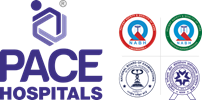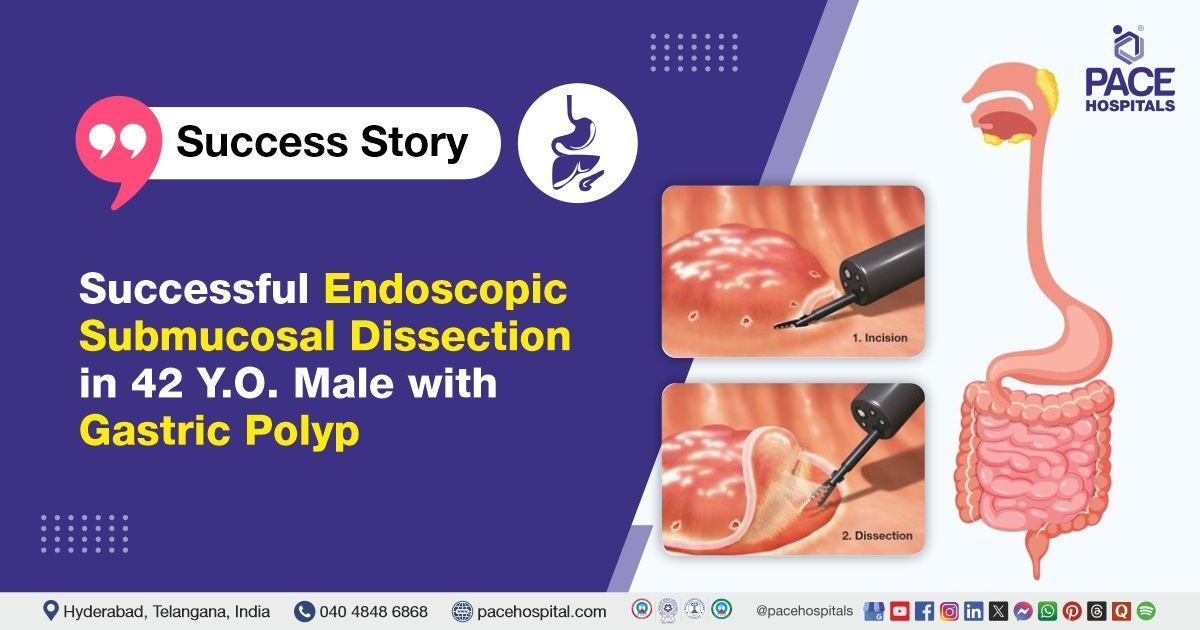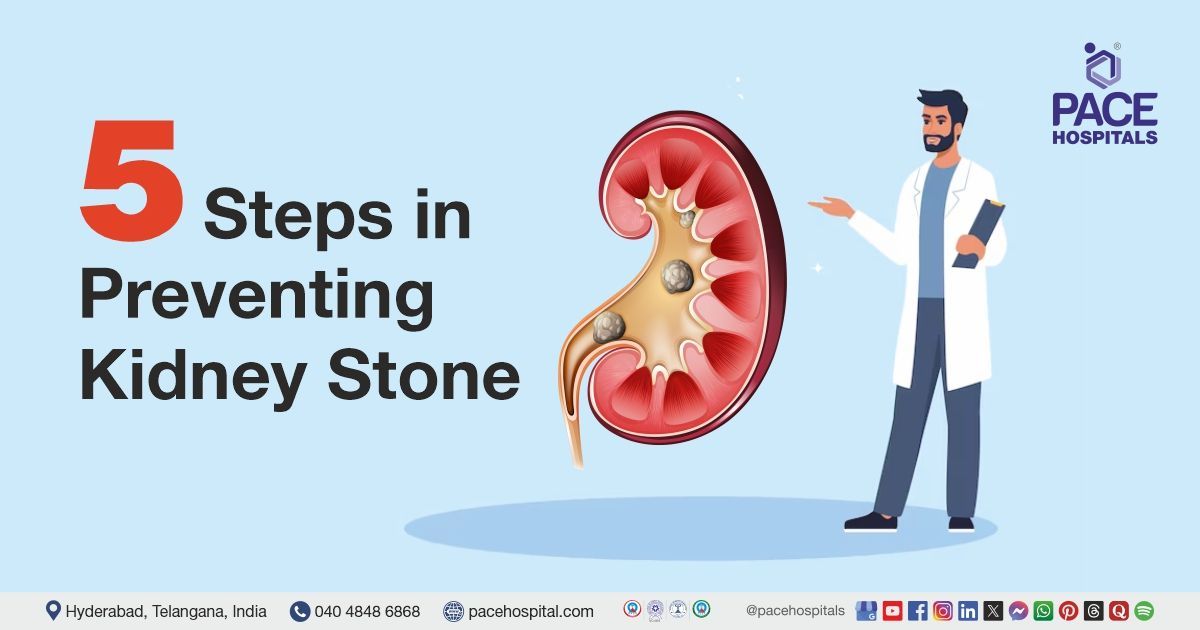Successful Endoscopic Submucosal Dissection in 42-Year-Old with Gastric Polyp
PACE Hospitals
PACE Hospitals’ expert Gastroenterology team successfully performed Endoscopic Submucosal Dissection (ESD) on a 42-year-old male diagnosed with Gastric Polyps (growths that originated from the lining of the stomach). The procedure aimed to relieve abdominal bloating experienced after meals and to ensure complete removal of the polyp, thereby reducing the risk of recurrence and potential malignant transformation. This minimally invasive intervention facilitated faster recovery, symptom relief, and enhanced the patient’s overall quality of life.
Chief Complaints
A 42-year-old male patient with a
Body Mass Index (BMI) of 21 presented to the Gastroenterology Department at
PACE Hospitals, Hitech City, Hyderabad, with a chief complaint of abdominal bloating after meals, which had been persisting for a long time.
Past Medical History
The patient had undergone an upper gastrointestinal endoscopy (UGIE) one month earlier, which revealed a gastric polyp an important finding that guided subsequent management.
On Examination
Upon admission, the patient was conscious, oriented, and in fair general condition with stable vital signs. Abdominal examination revealed mild distension without tenderness, palpable mass, or organomegaly. The abdomen was soft, non-tender, and with normal bowel sounds. There was no evidence of peripheral lymphadenopathy. Cardiovascular, respiratory, and neurological examinations were normal.
Diagnosis
After admission to PACE Hospitals, the patient underwent a comprehensive clinical evaluation, along with a detailed review of his prior medical records and diagnostic reports by the Gastroenterology team.
An upper gastrointestinal endoscopy (UGIE): Previously revealed a gastric polyp larger than 1 cm in diameter. Given the patient’s longstanding postprandial bloating, the size and location of the polyp were considered likely causes of his symptoms.
Arterial blood gas analysis: It revealed a mildly acidotic pH and a slightly elevated partial carbon dioxide (pCO₂), indicating a component of respiratory acidosis. The complete blood count showed neutrophilic predominance. Other laboratory parameters, including fasting blood sugar, electrolytes, renal function, and chest X-ray, were within normal limits.
Based on the confirmed findings, the patient was advised to undergo the
Gastric Polyp Removal Treatment in Hyderabad, India, under the expert care of the Gastroenterology Department.
Medical Decision Making
After consultation with Dr. Govind verma, a gastroenterologist, and cross-consultation with Dr. M Sudhir, and Dr. Padma Priya, a comprehensive evaluation was carried out to determine the most appropriate diagnostic and therapeutic approach for the patient. Based on their expert assessment, it was concluded that Endoscopic sub mucosal dissection (ESD) would be the most effective procedure to address the patient’s condition.
The patient and his family were thoroughly counselled regarding the severity of the condition, the details of the procedure, potential risks, and the necessity of the procedure to restore function and promote optimal recovery.
Surgical Procedure
Following the decision, the patient was scheduled to undergo Endoscopic Submucosal Dissection (ESD) in Hyderabad at PACE Hospitals under the expert supervision of the Gastroenterology Department to ensure optimal care and a smooth recovery process.
The procedure was performed in the following steps:
- Anesthesia and Lesion Identification: The procedure was performed under general anesthesia. The gastric polyp was precisely identified and its margins were marked using an endoscopic electrosurgical knife.
- Submucosal Injection: A solution of saline mixed with alpha and beta adrenergic agonist and dye was injected into the submucosal layer beneath the polyp to lift the lesion away from the muscularis propria and create a safety cushion.
- Mucosal Incision: A circumferential incision was made around the marked borders of the lesion using a specialized endoscopic knife.
- Submucosal Dissection: The submucosal layer was carefully dissected to separate the polyp from the underlying tissue, allowing for en bloc removal of the lesion while minimizing injury to deeper layers.
- Lesion Removal and Hemostasis: The polyp was completely resected and retrieved endoscopically. Bleeding was managed as needed.
- Post-procedure Assessment: The resection site was thoroughly inspected for any signs of bleeding or perforation, and preventive measures were taken as required. The specimen was sent for histopathological examination. The procedure was completed without any complications.
Postoperative Care
The postoperative recovery was uneventful, during hospital stay, the patient was treated with intravenous fluids, intravenous antibiotics, analgesics, proton pump inhibitors (PPIs), and other supportive medications to promote recovery and prevent infection. He remained stable throughout and was discharged in good condition with appropriate postoperative care instructions.
Discharge Medications
Upon discharge, the patient was prescribed a combination of medications, including antibiotics to prevent and treat bacterial infections, proton pump inhibitors to reduce stomach acid and protect the gastric lining, and gastrointestinal protectants to aid in the healing of ulcers and prevent further irritation. This regimen was designed to promote recovery, minimize the risk of postoperative complications, and support overall gastrointestinal health. The patient was also counselled on the importance of medication adherence and regular follow-up for optimal recovery.
Advice on Discharge
The patient was advised to follow a soft diet for five days to promote healing and reduce gastrointestinal irritation.
Emergency Care
The patient was informed to contact the
emergency ward at PACE Hospitals in case of any emergency or development of symptoms like fever, abdominal pain, bloating or vomiting.
Review and Follow-up Notes
The patient was advised to return for a follow-up visit with the Gastroenterologist in Hyderabad at PACE Hospitals, after 1 month.
Conclusion
This case highlights the effectiveness of Endoscopic Submucosal Dissection (ESD) as a minimally invasive and curative treatment for gastric polyps. It enabled complete polyp removal, alleviation of chronic postprandial bloating, and reduced the risk of malignant transformation. The patient recovered well postoperatively, demonstrating the value of expert multidisciplinary care in achieving optimal outcomes.
The Minimally Invasive Advantage of Endoscopic Submucosal Dissection (ESD) for Gastric Lesions
Endoscopic submucosal dissection (ESD) significantly improves quality of life for patients compared to traditional surgery. It preserves the natural structure and function of the stomach, avoiding the need for major resections. Patients experience less postoperative pain and discomfort due to the minimally invasive nature of the procedure, and hospital stays are shorter, allowing for a quicker return to daily activities and work. There is a lower risk of surgical complications, such as infections or wound issues, which further supports faster recovery. Nutritional status and gastrointestinal function are better maintained following ESD, reducing the likelihood of long-term digestive problems. Long-term studies show that patients who undergo ESD under the care of an experienced
gastroenterologist/gastroenterology doctor report stable or improved quality of life, with fewer limitations on eating and lifestyle. Overall, ESD offers a safe, effective, and patient-friendly alternative to open surgery for suitable gastric lesions, promoting both physical and psychological well-being.
Share on
Request an appointment
Fill in the appointment form or call us instantly to book a confirmed appointment with our super specialist at 04048486868











